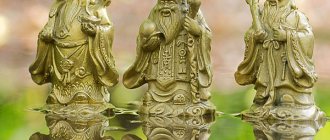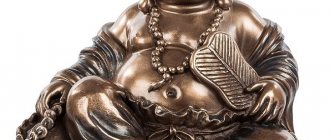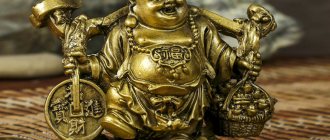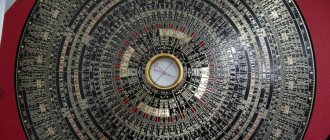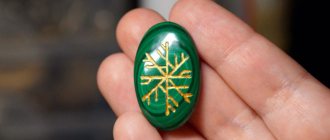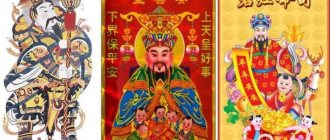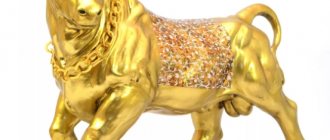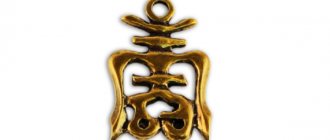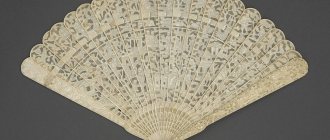Magic amulets and amulets have been used since ancient times. And they still do not lose their relevance. One of the most common and interesting ones are Buddhist mystical symbols. In this religion, talismans are given great importance. They are widespread in China, Tibet, India and other countries.
ATTENTION! If a person wears an imperial amulet on himself, he will never be poor. His debts are closed and a streak of luck sets in, which brings him into a comfortable life. With an imperial amulet, money will come in abundance - there will be much more of it than you expect... Read more"
What is the power of Buddhist amulets?
Buddhism is a religious teaching. Its founder is considered to be an Indian prince named Siddharth Gautam. Upon reaching the age of thirty, he renounced rule and family and set out to search for the meaning of life. There are various Buddhist amulets in Buddhism. The materials for their manufacture are wood, stone, clay or paper. The most powerful amulets are those made of silver or gold. Also, many symbols in Buddhism are applied to the body in the form of tattoos.
These talismans have the following purposes:
Talismans help achieve inner harmony
- protect from evil forces;
- achieve inner harmony;
- destroy harmful effects on energy;
- receive luck, material wealth and health.
These amulets must be consecrated by lamas in monasteries. Special rituals are performed on them, after which these objects become powerful protective symbols.
Features of religion
Buddhism is a doctrine of spiritual awakening practiced by many peoples with different traditions and cultures.
The founder of the religion is considered to be Siddhartha Gautama, who was later named Buddha. They practice the Buddhist faith in Mongolia, Tibet, India and China. In each country, the fundamentals of religious teaching are different, but despite the differences, they are based everywhere on 4 noble truths:
- Everything is dukkha. Frustration, anxiety, fears, dissatisfaction, etc.
- Dukha must have a cause.
- You can get rid of dukkha by solving the cause.
- The path to get rid of it leads to nirvana.
Adherents of this religion are always calm and peaceful.
The main distinguishing features of Buddhists from people professing other religions are calmness and tranquility, peacefulness and a smiling face. It is believed that the basis of life is suffering, which arises from human desires, and the soul passes from one body to another every time. Therefore, all forms are transitory. Another important religious tenet is the slogan “What goes around comes around.” That is why the life of those who profess faith is based on the performance of good deeds and the renunciation of violence, alcohol and drugs.
Figurines of Buddha and his prototypes
Images, figurines of Buddha or other cult personalities are often used as talismans. Such products are made of clay, metal, and painted on canvas or paper. Buddha is the personification of devotion to faith, the search for true paths that will help get rid of earthly suffering.
Tibetan lamas and other adherents of this religious teaching believe that there are certain deities who are endowed with a higher mind. Buddhist magical amulets include:
Amitayus increases human internal energy resources
- Samantabhadra. It is the Buddha who enlightens, who reveals the true state of things;
- Amitayus. Increases a person’s internal energy resources, helps get rid of various ailments;
- Amitabha. This is a symbol of achieving Nirvana, helps the soul to be successfully reborn in the flesh;
- Mahakala. It is a strong amulet against evil spirits and helps maintain health;
- White Mahakala. It is a powerful protective symbol for its owner;
- Chakrasamvara. Helps you discover new abilities;
- Vaishravana. Helps increase financial well-being;
- Trimurti. He is a triune Buddhist deity, thanks to whom one can protect oneself from illnesses;
- Vajrakilaya. This is an angry deity who will help protect against damage, the evil eye, and negative magical influences;
- Shakyamuni. It will help on the path of self-knowledge and self-purification.
Ancient swastika
The swastika is an ornament that is found among many peoples on the planet. It was especially often used by Buddhists, who covered clothing with a similar pattern, as well as the walls of religious buildings. In a general sense, the swastika symbolizes the unity of the four elements, cardinal directions, seasons, as well as the opposition of opposites - light and dark, good and evil, or, for example, yin and yang.
Plant and animal amulets
The lotus represents wisdom, enlightenment, perfection
Adherents of Buddhism have always been kind to representatives of flora and fauna. Among them, many plants are considered sacred and are depicted as protective symbols:
- lotus is a water sign, personifies wisdom, enlightenment, perfection;
- goldfish - a paired talisman that helps prevent disagreements in the family and attracts financial stability;
- elephant - identified with spiritual perfection;
- the tiger is strength and power;
- The cat is the personification of the hearth and protects the family.
Most often, animalistic amulets are applied to the body and made in the form of figurines. They are placed in the house in order to cleanse it of negative influences and attract good luck and prosperity.
Ornament is one of the manifestations of folk art. Translated from Latin it means “pattern, decoration.” Each national culture has developed its own system of ornamentation - motifs, shapes, placement on the surface to be decorated. By the ornament, you can immediately determine which national culture the work of art belongs to. It should be noted that ornament as a cultural phenomenon found its greatest embodiment in folk art. Gradually, stable forms and principles of pattern construction emerged, which largely determined the national artistic characteristics of the traditions of different peoples. The main feature of the ornament is that it is not an independent type of creativity, but serves as a design and decoration for works of decorative and applied art. In addition to the visual and emotional impact, the ornament has a deep symbolic meaning.
Buryat folk ornament has many common features with the ornament of nomadic and semi-nomadic peoples of Central Asia and Southern Siberia.
Based on the type of figurative element or motif, Buryat ornament is divided into types:
1. Geometric: points, lines (broken, straight, zigzag), circles, rhombuses, polyhedra, stars, crosses, etc.
2. Animalistic, zoomorphic, stylizing figures or parts of figures of real or fantastic animals (ram’s horn, eagle, etc.)
3. Floral, stylizing leaves, fruits, flowers, trees, etc.
The proposed classification of ornaments is conditional, since the variety of existing ornamental motifs is not always amenable to precise definition.
Geometric ornament is characterized not so much by the variety of figures as by the variability of their execution and is the most numerous group in terms of diversity, consisting of sticks, crosses, rhombuses and teeth. Most Buryat geometric patterns are built according to the law of a rhythmic series.
The ornamental “teeth” motif is often used to decorate the side edges of chest lids. “Prongs” often decorate the front walls of chests. “zigzag” is often found in the form of embroidery on fur coats, high fur boots, and socks.
When decorating artistic products, Buryats often use the symbolism of a circle - a sign denoting the sun, moon, and sky.
It is known that images of the sun and moon are on ongons - sacred images of deities among Buryat shamanists. Images of the sun and moon are often found in the decoration of quivers of nomadic peoples, including the Buryats.
Of particular interest is the ornament on some examples of the Narkhinsag decoration (ritual decoration of the Buryat bride) - an image of a cross and a circle, the semantics of which is associated with the cult of fire. Fire, according to the Buryats, was a good deity and patron of one kind or another. The cross was understood as a symbol of fire and was associated with the concept of the beginning of a new life (married couple), with the wish for well-being and fertility of the newly created family. The arrow on the bride's jewelry means a ray of sun. Thus, Buryat jewelry was considered as talismans that protected the happiness and well-being of a young family.
Geometric patterns
This group is the most extensive and is represented by four types of patterns:
- hammer;
- network;
- circle;
- swastika.
Hammer ornament
“Alkhan hee” (“hammer ornament”) is somewhat similar to the Greek meander, however, it has a huge number of varieties. The meander among Mongol-speaking peoples expresses the idea of perpetual motion. Hammer patterns were applied to objects made of hard and soft materials. It can be found on the wooden parts of the yurt, furniture, felt carpets, embroidery, clothing, dishes, harness, and musical instruments. In the old days, only very expensive objects were decorated with a meander, however, now the “hammer” ornament is found everywhere. Below are the templates for this ornament.
Network
“Ulzy” (“wickerwork”) is an ancient ornament symbolizing happiness, prosperity, and longevity. This very revered and widespread pattern in our time has many variations, but the most common is the ten-eye knot. Ulzy is applied in the center of the composition in the form of a checkered or curvilinear weave and is sometimes additionally braided with plant patterns. This sign can be depicted on any object made of metal, wood, or soft material if the manufacturer wants to show his good intentions and wishes. In this case, the ulzy is unusually similar both in appearance and in meaning to the Celtic pattern.
Circle
“Arc hee” (circle) is another very popular geometric pattern. The circle symbolizes eternity, cyclical infinity. Man “spotted” the cycle of changing events in the natural phenomena of the alternation of seasons, and this analogy is transferred to public life. All the time from birth to death is a movement in a circle, the “wheel of life” (sansaryn horde). The eve of the celebration of Sagaalgan - the New Year's Eve among the Buryats - is called "bγtγγ γder" (deaf, closed evening). This evening closes the circle of the old year and everything that originated in it must come out of this closed space, starting a new round of the next year. Therefore, the image of a circle is often found on metal products, quivers, men’s and women’s jewelry, on ritual objects and clothing, in furniture painting, and the Buryat circle dance “yokhor” is performed by moving in a circle. Other elements of the ornament can be decorated in a circle.
In a large group of animalistic, zoomorphic ornaments, the horn-shaped ornament depicting a ram's horn - khusyn eber hee - is widely represented. Forming numerous variations, it symbolizes fertility, wealth, abundance and prosperity. In the culture of nomadic peoples, including the Buryats, images of animals played the role of amulets. “Ram's horn” is often found in combination with the image of the sun and moon, thereby enhancing the energy of the decoration.
In folk art, symbolic images of an eagle and a deer are often found.
On things of various kinds involved in the everyday life of the Buryats, you can see an ornament that includes drawings of five key animals “taban khushuu mal” bred in the region. This is due to the fact that cattle breeding has long been very important in Buryatia. In addition to the actual images of goats and rams, an ornament in the form of their horns, eber ugalza (literally translated, this word means “horned ornament”), which was applied to objects with wishes of wealth and fertility, is popular. The word “ugalza” itself means not only “horn”, it is also the name of a male mountain sheep, which can be found in the Okinsky region of Buryatia, as well as in neighboring Mongolia. These rams grow very beautiful spiral-shaped horns, which is why the coils of horns became the prototype of the ornament for ancient hunters.
Zoomorphic patterns can be divided into groups:
- Taban hushuu is small. This design is applied most often and represents domestic animals, which have been bred by nomads since ancient times. These include camels, cows, goats, rams and horses.
- Animals of the Buryat calendar. To this day, the eastern calendar, which is used by Mongol-speaking tribes, and in particular the Buryats, differs from that accepted in Asia. Each animal here has its own name and is designed to bring certain benefits to the house. For example, bisheng (monkey) will contribute to the development of creative abilities, and mogoi (snake) will give wisdom.
- Ebere ugalza. This ornament is often called “horn-shaped” and is considered one of the most commonly used.
The basis of ornaments of plant origin is living nature, while the symbols are very restrained and laconic. Floral patterns in general are a symbol of beauty and life.
Floral patterns became widespread in blacksmith work in the ornamentation of quivers, archers, horse harnesses, belts, onivas, and women's jewelry. Stylized tree decorations are often used in the decoration of mittens.
Ornaments in this category are divided into the following groups:
- deciduous;
- floral;
- lotus
Elements from the latter group are often found in Buddhist culture. Monks and deities are depicted holding a lotus flower. For the Buryats, the lotus is a symbol of rebirth and the victory of life over death.
The color of the Buryat ornament was primarily determined by the color of mineral dyes that existed in nature. First of all, these are blue, red, black colors. Subsequently, they began to use brighter and more varied colors, which enhanced the energy of the image.
Modern Buryat ornament does not lose its deep connection with folk tradition. It develops, takes on new forms, is saturated with a rich range of colors, but still has a deep meaning and carries the strong energy of the Buryat people.
Mandalas
People who are not associated with Eastern beliefs and traditions can use mandalas as protective symbols. These are special patterns and images that are used in a toga to concentrate thoughts and spiritual improvement.
Mandalas are used as protective symbols
The symbol of the model of the Universe are special geometric figures that are used in mandalas. They have a complex structure, they personify the interconnection of all processes in the Universe. Such talismans are used to improve your health and strengthen your energy.
Hammer patterns
The hammer ornament among the Mongol-speaking tribes was applied only to especially valuable things. This pattern is also often called “meander” or “alkhan hee”. The last name was derived from the Mongolian word “alha”, which in exact translation means “hammer”. This ornament symbolized movement in the broad sense of the word. It means the eternal circulation of all things in the Universe, which is in continuous motion. As long as it does not stop, life on the planet continues. Today, meander is applied to various Buryat products quite often. It is one of the most popular and widespread, so most often tourists buy souvenirs with this pattern.
Other types
There are also other varieties of Buddhist symbols:
- Om sign. This is a sacred syllable. In Buddhism, it is believed that the entire Universe originated from it. It is written down on paper or wood;
- white umbrella – is a protection against negative thoughts, depression, emotional decline;
- bowl – protects against diseases, gives longevity;
- white shell - personifies purity and pleasure;
- knot - is a symbol of endless life, helps to direct energy in the right direction;
- victory banner - helps to overcome internal obstacles;
- the wheel of samsara - helps to gain wisdom;
- diamond talisman – is a powerful protective symbol;
- Dzi beads - protects against evil forces;
- red thread – protects against diseases and negative energy.
general information
A variety of Buddhist amulets
An analogy for angels in Buddhism are Siddhas. They are supernatural mythical forces with impressive magical abilities. Sometimes this name is used to call Mahasiddhas - great yogis and thinkers of Buddhist culture, but over time this concept changed and siddhams began to call the possibilities hidden in the human body, to reveal which it was necessary to know the Buddha and one’s inner world.
Over time, they acquired significance as conductors of the powers of knowledge and amplifiers of the siddhas of the human body. In fact, these are the same ethnic amulets inherent in any of the cultures of the world, but with their own specific religious characteristics. The main nuance, little understood by our people, is that there are a lot of Buddhist practices. Christianity in this regard is no different, but in it separate names have been invented for each of them, so the Orthodox do not identify themselves with Catholics or Protestants, but in Buddhism - everyone is Buddhist.
Important! The practices of Buddhism are not separate branches of belief; they are ways of achieving certain stages of knowledge through which each master of a given cult passes.
How Buddhists Advise Using Symbols
It is recommended to place the figurine in a place that is significant to the person.
There are many different uses of Buddhist symbols. The use is determined by the type of talismans and their purpose. There are general rules for using such items:
- amulets in the form of pendants, bracelets or rings should always be worn on the body without taking them off;
- It is recommended to place the figurine or figurine in a place that is significant for a person in the house or workplace;
- to protect your home from evil, it is recommended to hang a Buddhist symbol on the external wall of the house;
- amulets can be hung inside the home, near the front door, windows;
- install on the car dashboard, on windows to protect against accidents;
- apply sacred Buddhist symbols to the body in the form of a temporary or permanent tattoo;
- set at work to improve material well-being and relationships with colleagues.
It does not matter how and where to place amulets for personal use. The main thing is that they are chosen correctly and made in accordance with the canons.
Immutable rules
It’s not enough to give a scarf – you have to present it correctly.
It must be served only with both palms, with the thumbs supporting the upper part. The material must be clean, smoothed, folded in two even layers. It should be held with the outer side facing the person being congratulated.
It is equally important to accept the precious gift correctly: with both palms, with a slight bow and touching the forehead to the fabric. The donated item can be worn around the neck without tying it, or put away in the bosom, after carefully folding it.
When welcoming a guest into your home for the first time, you need to show hospitality and offer white treats on a silk scarf. There may be tea or money nearby.
Hadaks love order. It is believed that a person who knows how to keep them clean also knows how to save and multiply money. Neat people keep them on the altar, next to sacred objects, away from debris and dust.
Scarves received as gifts can be re-gifted, and can often be found tied to shrines, statues, trees, and monuments.
On the coat of arms of the Buryat Republic you can see this most interesting element - a blue ribbon on the bottom of the circle, which reflects the openness and love with which the Buryats receive guests.
Rules for choosing a personal Buddhist talisman
For an item to become your reliable assistant, it must be charged
In order for the selected item to become your reliable assistant, it must be properly charged. Special rituals are performed and prayers are read over this symbol. Remember that if you purchase a souvenir in a retail store, it will not have protective functions. Monks do not have the right to sell amulets. They can only charge a rental fee for using the artifact.
When choosing a Buddhist amulet, it is best to consult with the temple servants. The image itself, as well as the material from which the amulet is made, is of no small importance. An amulet made of paper or wood will easily give off its positive energy, will create comfort, and is suitable for home use. Wooden amulets are considered more effective. You need to choose a metal carefully, since a certain planet of the solar system is the patron of each metal.
It is not recommended to purchase several types of Buddhist amulets at once, especially if they have different energies and have different purposes. It is important to concentrate on your most important desire, for example, in order to recover from a disease, you need to select several symbols that are designed to improve health.
By carefully choosing a Buddhist amulet and taking it seriously, you can achieve success in the necessary area of life. Magic objects help individuals seeking self-development and self-improvement. Their energy should not be directed towards worsening the well-being of others.
Popular amulets
Buddhist talismans are not only wearable jewelry, but also statues, images on paper (similar to Christian icons), drawings on walls and cast metal panels. The most popular are:
Diamond protection is a paper amulet with a black and red image printed on it. The most powerful Buddhist amulet of success. It protects not only the owner, but also his thoughts.
The amulet of a Thai monk is a talisman designed to protect the consciousness of the owner. It is produced by applying an image to paper with a special fur brush.
Double Dorje is a symbol of connection with Buddha Amoghasiddhi and his protection.
Bodhisattwy Ksitigarbhy - is a piece of fabric with the mantra of the same name written on it. The combination of blue fabric and white paint is considered classic.
The amulet for resolving karmic debts is a white sheet with the mantra of the earth painted on it in red paint.
Amitabha is a mantra depicted in red paint on white paper, but after wearing it, it must be burned in a special bowl to say goodbye to karmic debts.
Doors - in this case, the Padmosnisha mantra is applied to the paper, designed to help the owner control his spirit and achieve enlightenment.
Therma Padmasambhava is a text amulet with a “spell” applied to the fabric in black paint, which helps protect oneself from external evil.
Buddhist amulets differ significantly from classical Slavic amulets, so to use them you need to carefully approach the issue and understand the subject. It is necessary to understand what Buddhism is and what religious rituals are characteristic of this belief.
